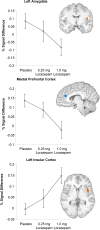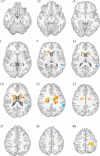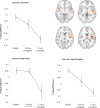Lorazepam dose-dependently decreases risk-taking related activation in limbic areas
- PMID: 17016713
- PMCID: PMC2839080
- DOI: 10.1007/s00213-006-0519-8
Lorazepam dose-dependently decreases risk-taking related activation in limbic areas
Abstract
Rationale: Several studies have examined the role of different neurotransmitter systems in modulating risk-taking behavior.
Objective: This investigation was aimed to determine whether the benzodiazepine lorazepam dose-dependently alters risk-taking behavior and underlying neural substrates.
Materials and methods: Fifteen healthy, nonsmoking, individuals (six women, nine men), aged 18-39 years (mean 27.6 +/- 1.4 years) with 12-18 years of education (mean 15.6 +/- 0.3 years) underwent functional magnetic resonance imaging while performing a risk-taking decision-making task.
Results: Our results show that lorazepam did not affect risky behavior at 0.25 and 1 mg, but dose-dependently attenuated activation in (a) the amygdala and medial prefrontal cortex during the response selection phase, and in (b) the bilateral insular cortex and amygdala during the outcome (i.e., rewarded or punished) phase. Furthermore, a lorazepam-induced increase in insular cortex activation was associated with less risky responses.
Conclusions: Taken together, our findings support the idea that GABAergic modulation in limbic and paralimbic structures is important during both the response selection and outcome phase of risk-taking decision-making.
Figures





References
-
- Baas JM, Grillon C, Bocker KB, Brack AA, Morgan CA, III, Kenemans JL, Verbaten MN. Benzodiazepines have no effect on fear-potentiated startle in humans. Psychopharmacology (Berl) 2002;161:233–247. - PubMed
-
- Bechara A. Neurobiology of decision-making: risk and reward. Semin.Clin.Neuropsychiatry. 2001;6:205–216. - PubMed
-
- Bechara A, Damasio H. Decision-making and addiction (part I): impaired activation of somatic states in substance dependent individuals when pondering decisions with negative future consequences. Neuropsychologia. 2002;40:1675–1689. - PubMed
-
- Botvinick M, Nystrom LE, Fissell K, Carter CS, Cohen JD. Conflict monitoring versus selection-for-action in anterior cingulate cortex. Nature. 1999 Nov 11;402:179–181. - PubMed
Publication types
MeSH terms
Substances
Grants and funding
LinkOut - more resources
Full Text Sources

